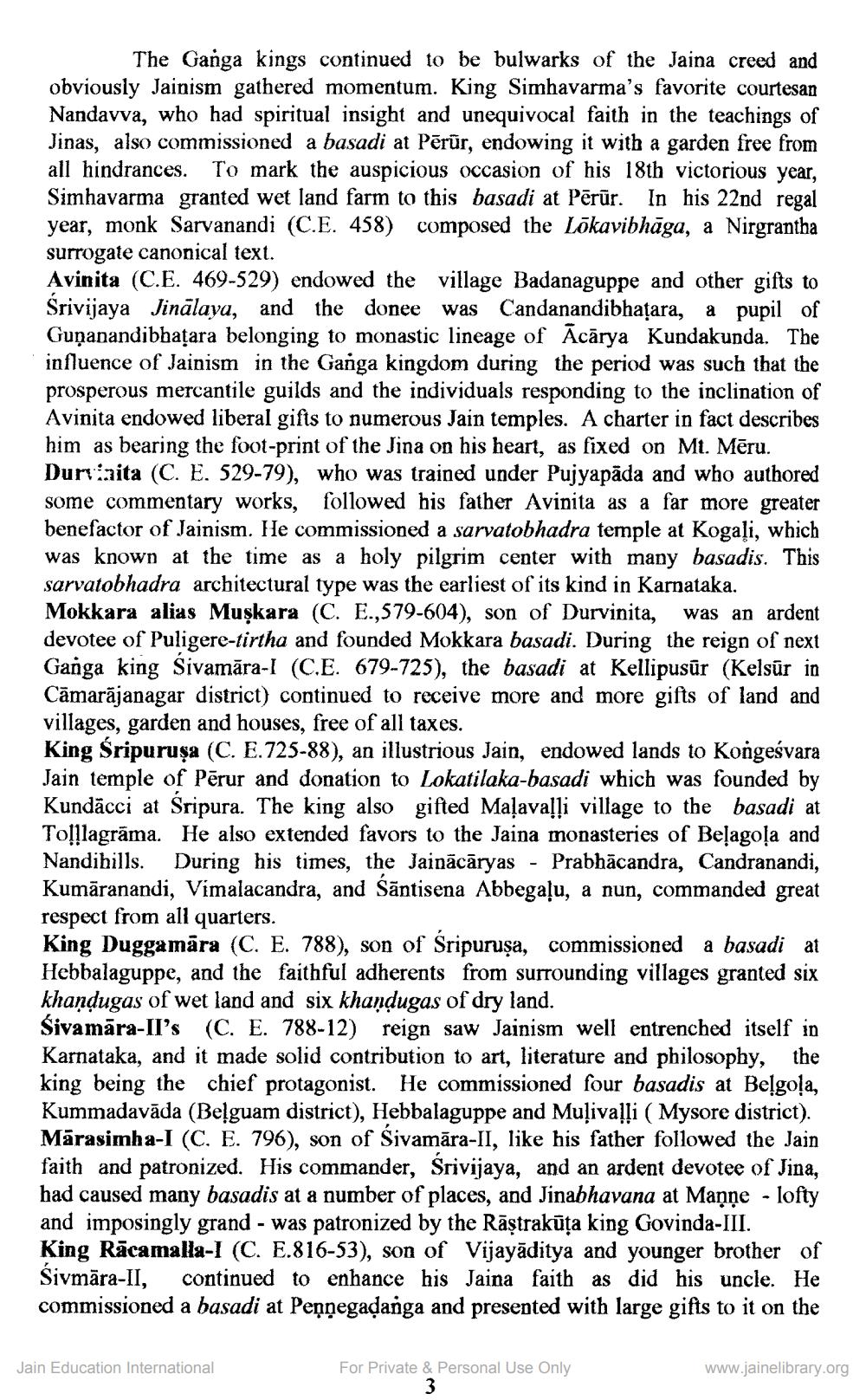Book Title: Jinamanjari 2000 04 No 21 Author(s): Jinamanjari Publisher: Canada Bramhi Jain Society Publication View full book textPage 6
________________ The Ganga kings continued to be bulwarks of the Jaina creed and obviously Jainism gathered momentum. King Simhavarma's favorite courtesan Nandavva, who had spiritual insight and unequivocal faith in the teachings of Jinas, also commissioned a basadi at Pērür, endowing it with a garden free from all hindrances. To mark the auspicious occasion of his 18th victorious year, Simhavarma granted wet land farm to this basadi at Pērūr. In his 22nd regal year, monk Sarvanandi (C.E. 458) composed the Lōkavibhāga, a Nirgrantha surrogate canonical text. Avinita (C.E. 469-529) endowed the village Badanaguppe and other gifts to Śrivijaya Jinālaya, and the donee was Candanandibhațara, a pupil of Gunanandibhațara belonging to monastic lineage of Acārya Kundakunda. The influence of Jainism in the Ganga kingdom during the period was such that the prosperous mercantile guilds and the individuals responding to the inclination of Avinita endowed liberal gifts to numerous Jain temples. A charter in fact describes him as bearing the foot-print of the Jina on his heart, as fixed on Mt. Mēru. Durviaita (C. E. 529-79), who was trained under Pujyapada and who authored some commentary works, followed his father Avinita as a far more greater benefactor of Jainism. He commissioned a sarvatobhadra temple at Kogali, which was known at the time as a holy pilgrim center with many basadis. This sarvatobhadra architectural type was the earliest of its kind in Karnataka. Mokkara alias Muskara (C. E.,579-604), son of Durvinita, was an ardent devotee of Puligere-tirtha and founded Mokkara basadi. During the reign of next Ganga king Sivamara-I (C.E. 679-725), the basadi at Kellipusūr (Kelsûr in Camarajanagar district) continued to receive more and more gifts of land and villages, garden and houses, free of all taxes. King Śripuruşa (C. E.725-88), an illustrious Jain, endowed lands to Kongeśvara Jain temple of Perur and donation to Lokatilaka-basadi which was founded by Kundäcci at Sripura. The king also gifted Malavalli village to the basadi at Tolllagrāma. He also extended favors to the Jaina monasteries of Belagola and Nandihills. During his times, the Jainācāryas - Prabhācandra, Candranandi, Kumāranandi, Vimalacandra, and Säntisena Abbegaļu, a nun, commanded great respect from all quarters. King Duggamāra (C. E. 788), son of Sripurușa, commissioned a basadi at Hebbalaguppe, and the faithful adherents from surrounding villages granted six khandugas of wet land and six khaṇḍugas of dry land. Śivamāra-II's (C. E. 788-12) reign saw Jainism well entrenched itself in Karnataka, and it made solid contribution to art, literature and philosophy, the king being the chief protagonist. He commissioned four basadis at Belgola, Kummadavāda (Belguam district), Hebbalaguppe and Mulivalli (Mysore district). Mārasimha-I (C. E. 796), son of Śivamara-II, like his father followed the Jain faith and patronized. His commander, Śrivijaya, and an ardent devotee of Jina, had caused many basadis at a number of places, and Jinabhavana at Manne - lofty and imposingly grand - was patronized by the Rāṣtrakūṭa king Govinda-III. King Racamalla-I (C. E.816-53), son of Vijayaditya and younger brother of Sivmāra-II, continued to enhance his Jaina faith as did his uncle. He commissioned a basadi at Pennegadanga and presented with large gifts to it on the Jain Education International For Private & Personal Use Only 3 www.jainelibrary.orgPage Navigation
1 ... 4 5 6 7 8 9 10 11 12 13 14 15 16 17 18 19 20 21 22 23 24 25 26 27 28 29 30 31 32 33 34 35 36 37 38 39 40 41 42 43 44 45 46 47 48 49 50 51 52 53 54 55 56 57 58 59 60 61 62 ... 88
